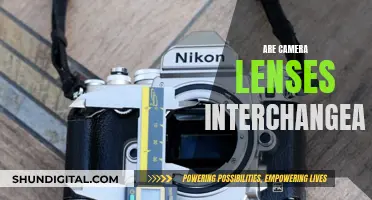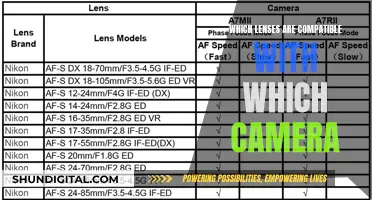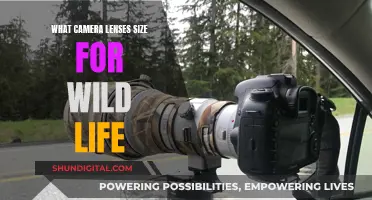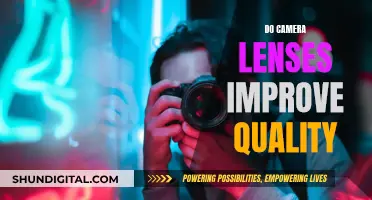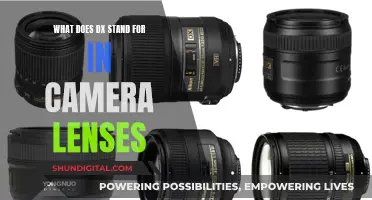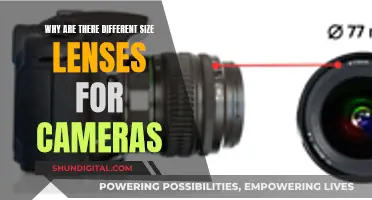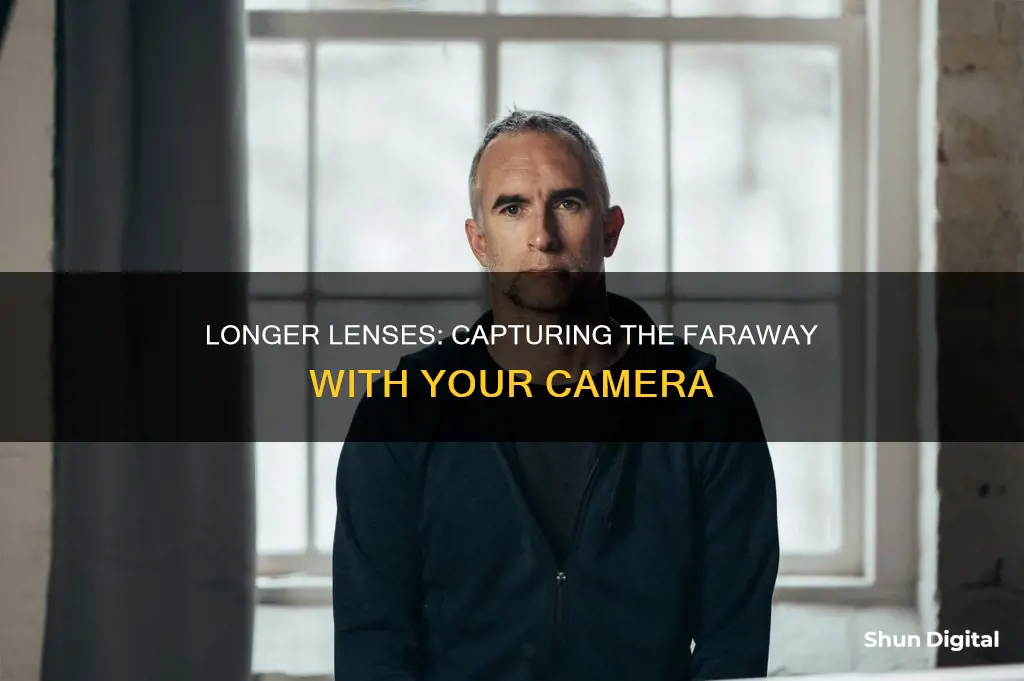
Longer lenses, or telephoto lenses, are a powerful tool for photographers and filmmakers alike. They can be used to isolate a subject, magnify distant objects, and compress space. This makes them ideal for portrait photography, sports photography, wildlife photography, and cinematography. They also make it easier to blur the background of an image, creating a shallow depth of field that draws attention to the subject. Additionally, longer lenses can help photographers capture images without invading their subject's personal space, making them useful for street photography and documentary photography.
| Characteristics | Values |
|---|---|
| Focal length | Longer than the diagonal measure of the film or sensor that receives its image |
| Angle of view | Narrower |
| Magnification | Distant objects appear magnified |
| Perspective | Compresses or flattens |
| Bokeh | More pronounced |
| Shutter speed | Requires faster shutter speed to avoid camera shake |
| Image stabilisation | Required |
| Tripod | Recommended |
| Weight | Heavier |
| Use case | Portraits, wildlife, sports, cinematography |
What You'll Learn

Capturing portraits
Longer lenses also offer a more pleasing perspective and create a "bokeh" effect, where the background appears as beautiful blobs of light and colour. This isolates your subject, making them stand out from the frame. Additionally, the compression effect of longer lenses can help flatter your subject's features, which is always desirable in portrait photography.
When choosing a lens for portrait photography, you may want to consider a prime lens, which typically has wider maximum apertures, creating blurrier backgrounds and better highlighting your subject. The 85mm lens is a popular choice for portraits, as it allows you to maintain a reasonable distance from your subject while achieving a narrower field of view for better focus.
If you're shooting full-length or waist-length portraits, a 50mm lens can be a good option, as it has a wide field of view and lets you capture more of your subject's body and background. However, for intimate headshots, an 85mm or 135mm lens may be a better choice, as they offer more flexibility in terms of vantage points and working distance.
When using longer lenses for portraits, remember that small movements can create a lot of blur, so consider using a tripod for added stability. Additionally, a faster shutter speed can help mitigate the effects of camera shake.
With the right techniques and equipment, you can capture stunning portraits that highlight your subject's unique features and engage the viewer.
Attaching Camera Lenses: String Method for Quick Setup
You may want to see also

Shooting buildings
- Longer lenses magnify distant objects, so even the tiniest movements can create a lot of blur in your photograph. To avoid this, use quicker shutter speeds and consider using a tripod for more stability.
- If you can't access the roof of a building to get closer to details like statues or carvings, a longer lens can help you capture those details from the ground.
- Longer lenses can make buildings appear flatter, which may not always be seen as flattering. 85mm lenses are often used for portrait photography as they are seen as flattering to human features.
- A tilt-shift lens can be used to correct the distortion that occurs when shooting buildings from the ground. This type of lens shifts the glass inside the lens to correct the converging lines, making the building appear straight.
- When shooting buildings, it's important to level your camera to ensure the horizon is straight. You can use a spirit bubble mounted to the hot shoe of your camera or the in-built virtual level overlay in live view to help with this.
- When shooting buildings with a longer lens, consider the foreground elements and how they will be affected. For example, a podium in the foreground may appear stretched and unnatural if you're too close to the building.
- If you want to show the ground that a building sits on, a longer lens may not be the best option as it will require you to tilt your camera up, resulting in a significant loss of the bottom part of the image.
- If you want to capture the entire building in the frame without tilting your camera, a wider lens like a 17mm tilt-shift lens can be a better option.
- When shooting buildings, consider the story you want to tell. Do you want to focus on the building in isolation, or do you want to place it within its immediate surroundings? The lens you choose will impact the story you tell.
Understanding Camera Focal Lengths: A Beginner's Guide
You may want to see also

Photographing wildlife
Wildlife photography can be challenging, but with the right lens, you can get some amazing shots. Here are some tips for photographing wildlife:
- Choose the right lens: For wildlife photography, you'll typically need a telephoto lens, which will allow you to get close-up shots of animals without disturbing them. Prime lenses tend to be more expensive and have a wider maximum aperture, but zoom lenses offer more flexibility and are usually more affordable.
- Consider a zoom lens: Zoom lenses give you a range of focal lengths to work with, allowing for more creative compositions. They are also usually more affordable than prime lenses. However, the maximum aperture of a zoom lens may vary as you zoom in, so keep that in mind when choosing one.
- Go for a longer focal length: A longer focal length will give you more telephoto reach, which is ideal for wildlife photography. Look for lenses with a focal length of at least 400mm.
- Use a tripod: Wildlife photography often requires a lot of waiting and can involve heavy equipment. A tripod will help you keep your camera steady and reduce fatigue during long shoots.
- Work with fast shutter speeds: Wildlife moves quickly, so you'll need a fast shutter speed to capture sharp images. A good rule of thumb is to use a shutter speed that's faster than your focal length. For example, if you're shooting at 200mm, use a shutter speed of 1/200 or higher.
- Invest in image stabilization: Image stabilization can help compensate for camera shake, allowing you to use slower shutter speeds without blurring your images. This is especially useful in low-light conditions or when shooting moving subjects.
- Pay attention to your background: A longer lens will compress the background, bringing it closer to your subject. This can be useful for isolating your subject and creating a pleasing bokeh effect.
- Practice, practice, practice: Wildlife photography requires skill and knowledge to get the most out of your equipment. Practice using your lens and camera, experiment with different settings, and get to know your gear inside out.
Precision Alignment: Camera Lenses and Their Secrets
You may want to see also

Capturing sports/action
Capturing sports or action shots is a challenge for any photographer, but longer lenses can help you get the perfect image. Firstly, they allow you to get close to the action without physically needing to be there. This is especially useful if you don't have a press pass or are photographing dangerous sports. With a longer lens, you can position yourself in a safe spot and still get a great shot.
Longer lenses also have the benefit of compressing the space between objects, which can be used to great effect in sports photography. For example, you can make it seem like an athlete is closer to the finish line or make a basketball player seem closer to the hoop. This compression effect also helps to isolate the subject, ensuring the athlete or player is the main focus of the image.
Another advantage of longer lenses is their ability to blur the background. This is particularly useful in sports photography, where you want to separate the subject from any distractions in the background. The shallow depth of field created by longer lenses means that your subject will be in focus while the background is nicely blurred, adding a pleasing aesthetic to your image.
When shooting sports or action, it's essential to have the right shutter speed to capture sharp images. Longer lenses often require faster shutter speeds to mitigate the effects of camera shake, which is more noticeable with longer focal lengths. A good rule of thumb is to use a shutter speed that's faster than the focal length, such as shooting at 1/200 or higher for a 200mm lens.
Finally, longer lenses are ideal for capturing sports or action because they allow you to zoom in on the details. Whether it's the intensity in an athlete's eyes or the sweat flying off their brow, longer lenses give you the ability to magnify these moments and create powerful images that capture the emotion and energy of the event.
In conclusion, longer lenses are a valuable tool for sports and action photography, offering benefits such as increased magnification, background blur, and spatial compression. With the right techniques and settings, you can capture dynamic and captivating images that showcase the beauty and excitement of sports and action.
How Does an Eclipse Affect Camera Lenses?
You may want to see also

Shooting the moon
Planning
First, you need to plan when and where to shoot. The moon's phase and position in the sky will significantly impact your photo. You can use software, websites, and mobile applications to track the moon's position and phase. The phase of the moon will determine its illumination. A full moon will appear as a low-contrast white disc, while a partially illuminated moon will reveal its craters and shadows. Therefore, the night before or after a full moon is often considered the best time to shoot as it will provide more texture and detail.
Additionally, consider whether you want the moon to be the main subject or an element in a landscape image. If you opt for the latter, you will need to plan extensively. Decide where you want the moon to appear in your shot and plan accordingly.
Gear
To capture the moon, you will need a camera with a long lens. A single lens reflex (SLR) camera with a telephoto lens of at least 250mm will suffice. However, for more detail, a telephoto lens of 500mm to 600mm or a long focal length telescope is ideal. If you want to include landscape elements in your shot, a wide-angle lens can be useful. Additionally, a tripod is essential to minimise camera shake and ensure a steady shot. Other useful gear includes a remote shutter release or auto-timer to avoid blur, and a lens with image stabilisation to minimise camera shake and allow for slower shutter speeds.
Settings
When it comes to camera settings, there are a few key considerations. First, use a fast shutter speed to avoid motion blur. The moon moves at a speed of approximately 2,300 miles per hour, so a shutter speed of at least 1/20th of a second is recommended. Second, underexpose rather than overexpose your shot. The moon is a bright object, so you can use low ISO settings, but be careful not to overexpose the frame. Third, if you are shooting the moon against a distant foreground, such as a mountain or building, you can usually focus on the foreground, and the moon will also be in focus. However, if the foreground is closer, such as a tree or person, you may need to use focus stacking as it is challenging to get both the foreground and the moon in focus simultaneously. Finally, different focal lengths will impact the perceived size of the moon in your photo. A longer zoom lens will make the moon appear larger, so consider the composition you want and adjust your distance and focal length accordingly.
Post-processing
After capturing your photos, you can enhance them through post-processing. This can include adjusting exposure, contrast, and sharpness. Additionally, consider creating a mosaic image by capturing multiple shots with similar lighting conditions and stitching them together using software.
How Lenses Transform Your Camera's Vision
You may want to see also
Frequently asked questions
A long lens is a camera lens with a focal length longer than the diagonal measure of the film or sensor that the image is captured on.
Long lenses are great for capturing distant objects and making them appear magnified. They are also useful for isolating a subject by blurring the background and creating a shallow depth of field. Long lenses can also make it easier to capture portraits without invading the subject's personal space.
Long lenses are commonly used in sports photography, wildlife photography, cinematography, and portrait photography. They can help capture images of subjects that the photographer cannot get physically closer to.
Long lenses tend to be physically larger and heavier than other lenses. They are also more prone to camera shake due to their magnification, so they often need to be used with a tripod or monopod for stability.


